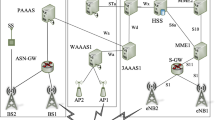Abstract
With the wide distribution of hot spots, in order to facilitate users to access the network at anytime and anywhere, the current network technology has developed a convenient and fast hot spot sharing system and has been popularized in daily life. However, the convenience of the information society also hides network security dangers. The purpose of this paper is to study and analyze the security problems existing in current Wi-Fi sharing applications by designing two different network authentication programs. In this paper, ieeee802.1x protocol is used for wireless access, eap-tls and RADIUS bidirectional authentication mechanism to achieve the authentication of access users, and one-time password authentication technology is used in Fat AP networking mode. Aiming at the defects of S/KEY protocol, such as server impersonation and system crash, an authentication scheme combining DES and RSA algorithm is proposed and implemented. The authentication scheme in network mode retains the advantage of simple operation of static cryptography system. By adding uncertainties, the security of the authentication system can be improved. The encrypted information is used to encrypt the transmitted information to ensure the confidentiality of the information during transmission. After successful authentication, session key negotiation is completed to ensure the security of subsequent communication. This scheme has a success rate of more than 95% after the experiment, is simple in design, high in security, low in cost, and does not need the participation of the third party, which is very suitable for solving the problems of user authentication and communication confidentiality in the shared system.







Similar content being viewed by others
References
Shin S, Wang H, Gu G (2015) A first step toward network security virtualization: from concept to prototype. IEEE Transact Inform Forens Secur 10(10):2236–2249
Pearce C, Zeadally S (2015) Ancillary impacts of multipath TCP on current and future network security. IEEE Internet Comput 19(5):58–65
Divya R, Vijayalakshmi V (2015) Analysis of multimodal biometric fusion based authentication techniques for network security. Int J Security Appl 9(4):239–246
Li X, Liu J, Ding B, Li Z, Wu H, Wang T (2019) A SDR-based verification platform for 802.11 PHY layer security authentication. World Wide Web, pp. 1-24
Scott-Hayward S, Natarajan S, Sezer S (2015) A survey of security in software defined networks. IEEE Commun Surveys Tutorials 18(1):623–654
He LM, Yan Z, Atiquzzaman M (2018) LTE/LTE-a network security data collection and analysis for security measurement: a survey. IEEE Access, PP(99), PP. 1–1
Silue DS, Wan W, Rizwan M (2016) Research and implementation of time synchronous dynamic password based on sm3 hash algorithm. Open J Appl Sci 6(13):893–902
de Chardon CM, Caruso G, Thomas I (2017) Bicycle sharing system ‘success’ determinants. Transp Res A Policy Pract 100:202–214
Alvarez-Valdes R, Belenguer JM, Benavent E, Bermudez JD, Muñoz F, Vercher E, Verdejo F (2016) Optimizing the level of service quality of a bike-sharing system. Omega 62:163–175
Shao SH, Khreishah A, Ayyash M (2015) Design of a visible-light-communication enhanced WiFi system. Comput Therm Sci 67(2):66–68
Banerjee A, Zosa BM, Allen D (2016) Implementation of an image sharing system significantly reduced repeat computed tomographic imaging in a regional trauma system. J Trauma Acute Care Surg 80(1):51–54
Chen S, Ma X, Nguyen TMTUnderstanding bike trip patterns leveraging bike sharing system open data. Front Comput Sci 11(1):77–81
Song Y, Sung KW, Han Y (2016) Impact of packet arrivals on Wi-fi and cellular system sharing unlicensed spectrum. IEEE Trans Veh Technol 65(12):10204–10208
Singh B, Goel R (2019) MCMC estimation of multi-component load-sharing system model and its application. Iran J Sci Technol Transact A: Sci 43(2):567–577
Pundir PS, Gupta PK (2018) Reliability estimation in load-sharing system model with application to real data. Ann Data Sci 5(1):69–91
Nguyen NT, Chang CC (2018) Untraceable biometric-based three-party authenticated key exchange for dynamic systems. Peer-to-Peer Network Appl 11(3):644–663
Miao D, Fu J, Lu Y, Li S, Chen CW (2016) A high-fidelity and low-interaction-delay screen sharing system. ACM Transact Multimedia Comput, Commun Appl (TOMM) 12(3):1–23
Nohara A, Shiramatsu S, Ozono T, Shintani T (2015) Developing a mountaineering plan sharing system based on information extraction from unstructured documents. Ieej Transact Electron Inform Syst 135(12):1470–1480
Lu M, Hsu SC, Chen PC, Lee WY (2018) Improving the sustainability of integrated transportation system with bike-sharing: a spatial agent-based approach. Sustain Cities Soc 41:44–51
Majima Y, Maekawa Y, Hirano K, Inotani T, Izumi T, Shimada S, Ishigame A (2018) Video review system for sharing tacit knowledge of clinical nursing practice. Studies Health Technol Inform 250:41–44
Li X, Niu JW, Liao JG (2015) Cryptanalysis of a dynamic identity-based remote user authentication scheme with verifiable password update. Int J Commun Syst 28(2):374–382
Liu ZH, Chen HW (2016) Cryptanalysis and improvement of quantum broadcast communication and authentication protocol with a quantum one-time pad. Chin Phys B 25(8):080308
Li CT, Lee CC, Weng CY, Chen SJ (2016) A secure dynamic identity and chaotic maps based user authentication and key agreement scheme for e-healthcare systems. J Med Syst 40(11):233
Liu HH (2017) The quick radio fingerprint collection method for a WiFi-based indoor positioning system. Mobile Networks Appl 22(1):61–71
Wu Y, Zhang S (2017) Research on indoor wireless access network of hybrid VLC-WiFi System. Semiconduct Optoelectron 38(6):853–856 and 861
Chen Z, Zhou K, Liao Q (2019) Quantum identity authentication scheme of vehicular ad-hoc networks. Int J Theor Phys 58(1):40–57
Author information
Authors and Affiliations
Corresponding author
Additional information
Publisher’s note
Springer Nature remains neutral with regard to jurisdictional claims in published maps and institutional affiliations.
Rights and permissions
About this article
Cite this article
Tao, H. The identity authentication of Wi-Fi system based on network security. Ann. Telecommun. 76, 313–320 (2021). https://doi.org/10.1007/s12243-020-00793-0
Received:
Accepted:
Published:
Issue Date:
DOI: https://doi.org/10.1007/s12243-020-00793-0




